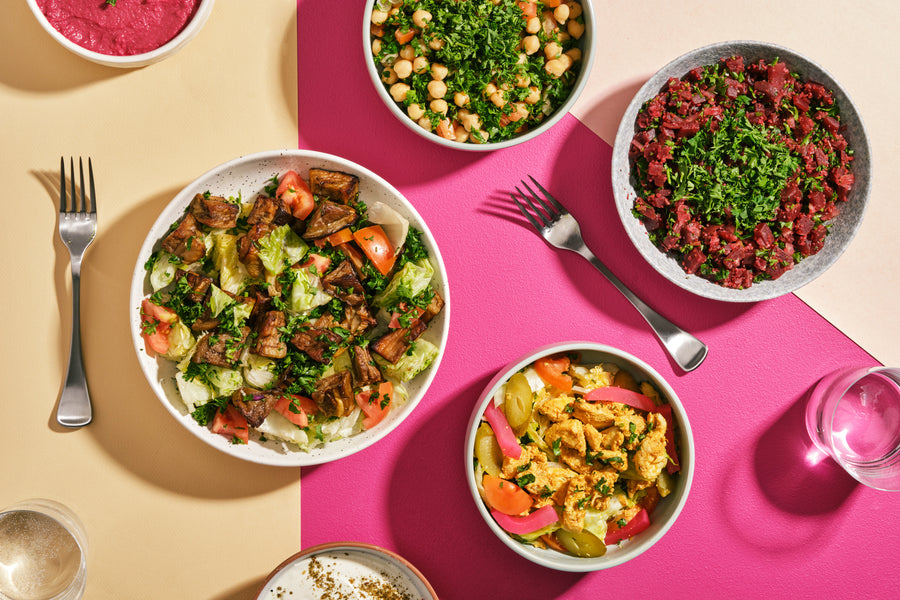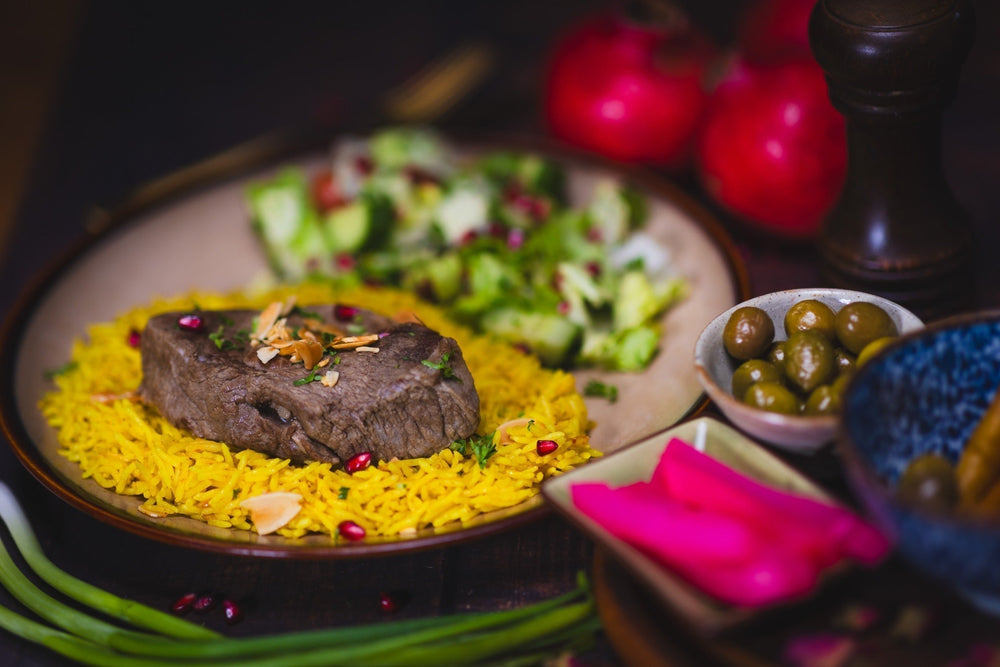Everything about the Rich Flavors and Traditions of Syrian Cuisine: A Culinary Trip
Syrian cuisine supplies a special mix of tastes and practices that show its rich cultural history. With staple ingredients like olive oil and garlic, along with a variety of spices, the meals are both diverse and inviting. From the intricate preparation of kibbeh to the pleasant appeal of baklava, each facet of this culinary landscape discloses deeper tales. As one explores the significance of these tastes, a better understanding of public eating and event emerges.
The Significance of Syrian Active Ingredients
The significance of Syrian active ingredients hinges on their abundant diversity and ingrained cultural significance. Influenced by the nation's different geography and background, Syrian food includes a vast variety of flavors, herbs, and fresh fruit and vegetables. Staples such as olive oil, garlic, and lemon supply a foundation, while flavors like sumac, coriander, and cumin add depth and intricacy to dishes.The usage of fresh natural herbs, including parsley and mint, highlights the relevance of seasonal components. Additionally, the area's fertile dirt returns an abundance of fruits and veggies, such as tomatoes, eggplants, and pomegranates, which are important to many dishes. Grains like bulgur and rice create the base of several dishes, underscoring the relevance of these components in Syrian culture. This blend of flavors shows not simply a culinary custom however likewise a tapestry of historic influences, making Syrian ingredients vital to understanding its cuisine's lively personality.

Iconic Dishes of Syrian Cuisine
Syrian food is renowned for its legendary meals that showcase a rich tapestry of appearances and flavors. Traditional meze plates offer a range of small meals that entice the taste buds, while hearty main dishes supply satisfying focal points for dishes (Afternoon Tea Vancouver). To complete the experience, a choice of scrumptious treats adds a wonderful note to the culinary trip
Standard Meze Plates

Hearty Main Courses
Passionate main courses function as the focal point of Syrian dining, showcasing a blend of flavors that reflect the country's rich culinary practices. Meals such as kebab hindi, featuring seasoned lamb skewers, and the popular mujaddara, a calming combination of lentils and rice, highlight using fragrant spices and fresh active ingredients. Another staple is the iconic kibbeh, made from bulgur wheat and minced meat, frequently served in different forms, consisting of baked, deep-fried, or raw. Additionally, the flavors of the land come active in recipes like stuffed veggies, referred to as mahshi, which are loaded with rice, meat, and natural herbs. These main dishes not just satisfy appetite however additionally inform stories of family celebrations and cultural heritage.
Mouth-watering Treats Selection
A wonderful range of desserts specifies the pleasant side of Syrian cuisine, offering an alluring end to any kind of dish. Among the most celebrated confections are baklava, fragile layers of phyllo bread loaded with nuts and soaked in syrup, and maamoul, shortbread-like cookies usually packed with dates or nuts. Knafeh, an abundant treat made from thin noodle-like bread soaked in syrup and layered with cheese, is a prominent choice, particularly throughout joyful events. In addition, the sweet and great smelling rice pudding, known as roz bil laban, provides a soothing finish. These scrumptious treats not just showcase the area's culinary knowledge yet additionally show the cultural heritage of Syria, making them treasured treats in both homes and dining establishments alike.
Typical Food Preparation Techniques
Contemporary conveniences have affected lots of culinary practices, traditional cooking strategies continue to be necessary to Syrian food. These methods usually emphasize making use of fresh, seasonal components and concentrate on slow-moving cooking to create abundant flavors. Methods such as barbecuing, braising, and cooking are prevalent, allowing the natural tastes of the ingredients to radiate through.One significant technique is the prep work of kibbeh, a recipe made from carefully ground meat and bulgur. It requires experienced hand-rolling right into different shapes and can be baked, fried, or served raw. In addition, the art of making bread, specifically pita, is main to numerous meals, often cooked in a conventional stone oven.Preservation methods like pickling and fermenting likewise play a vital duty, enhancing the variety of flavors discovered in Syrian recipes. These strategies not just mirror the area's farming heritage yet also promote a solid sense of neighborhood via shared culinary techniques.

The Duty of Spices in Flavoring
Seasonings function as the heart beat of Syrian food, infusing meals with complicated tastes and fragrant deepness. Each spice plays a crucial role, adding not only to taste but also to the cultural heritage of the area. Frequently utilized flavors include coriander, sumac, and cumin, each offering an unique profile that raises traditional dishes. Cumin offers warmth and earthiness, while sumac adds a zesty illumination, improving the general dish.Syrian cooks typically blend flavors to create unified accounts, showing the detailed balance of tastes that define the cuisine. The use of seasonings is not merely for flavoring; it additionally offers to maintain food and boost its dietary worth. This thoughtful consolidation highlights a deep understanding of the culinary arts, where spices come to be crucial writers, conveying the rich background and varied impacts that identify Syrian gastronomy. Ultimately, flavors are important in crafting genuine and remarkable Syrian meals.
Joyful customs and commemorative meals
Congratulatory meals in Syrian food are click to read marked by typical feast dishes that reflect the nation's abundant culinary heritage. Special celebrations typically include special routines that enhance the communal experience of dining. These customizeds not only honor the importance of the occasions but additionally strengthen familial and cultural bonds.
Typical Banquet Dishes
When family check that members collect to celebrate significant occasions in Syria, traditional feast dishes take facility stage, showcasing the abundant culinary heritage of the area. These gatherings usually include dynamic platters of mezze, consisting of hummus, baba ghanoush, and tabbouleh, which work as fascinating beginners. The primary training course commonly highlights lamb or chicken, marinated and cooked to perfection, often gone along with by great smelling rice pilaf or bulgur. One of one of the most precious meals is maqlooba, a layered rice recipe with veggies and meat, flipped upside down prior to offering. Sweets likewise play a vital role, with baklava and knafeh offering a pleasant finish to the meal. Each recipe not only delights the taste but likewise shows the ingrained practices and public spirit of Syrian culture.
Special Celebration Routines
Special occasions in Syria are marked by abundant rituals that intertwine food and festivity, mirroring the cultural significance of public celebrations. Commemorative meals usually include standard recipes such as kibbeh, tabbouleh, and different smoked meats, prepared with care and shared among family and pals. Throughout spiritual holidays like Eid al-Fitr and Eid al-Adha, families collaborated to prepare special desserts like maamoul, representing unity and delight. Wedding celebrations are especially sophisticated, featuring several courses and vivid screens of friendliness. These events are not merely concerning food; they include storytelling, music, and dancing, enhancing social bonds and cultural heritage. With these rituals, Syrians commemorate life's milestones, ensuring practices More about the author are passed down with generations, enhancing their cooking landscape.
The Relevance of Sharing and Area
Sharing dishes is a fundamental element of Syrian culture, mirroring the ingrained worths of area and link. In Syria, food is not simply food however a method of bringing people together. Family members and pals gather around the table to delight in standard meals, fostering bonds and producing lasting memories. This public eating experience emphasizes friendliness, where hosts most likely to terrific sizes to ensure every visitor really feels welcomed and nourished.The act of sharing food additionally represents kindness and solidarity, strengthening social ties within areas and larger communities. Throughout events, it is typical for people to offer each other, showcasing a spirit of togetherness that transcends uniqueness. Parties, whether huge or small, are frequently marked by the sharing of meals, where varied flavors and dishes integrated, mirroring the rich tapestry of Syrian society. As necessary, the significance of sharing and neighborhood in Syrian cuisine is not just a culinary custom however a crucial social method.
A Cooking Expedition of Syrian Sugary Foods
Frequently outweighed by tasty dishes, Syrian sweets hold a cherished place in the nation's culinary heritage (Afternoon Tea Vancouver). These confections mirror the area's rich history, blending tastes and techniques from numerous cultures. Standard treats like baklava, with its layers of phyllo pastry, nuts, and honey syrup, showcase the artistry entailed in Syrian cooking. Ma'amoul, a shortbread-like cookie loaded with nuts or dates, is typically planned for joyful celebrations, representing friendliness and celebration.Another cherished pleasant is Knafeh, a pastry saturated in syrup and split with cheese or lotion, supplying a wonderful contrast of textures. Syrians also enjoy a variety of fruit syrups and maintains, typically offered with tea or as part of a larger spread throughout events. These sugary foods not just satisfy the palate however also work as a bridge in between generations, protecting the customs and stories of Syrian culture with each delicious bite
Often Asked Concerns
What Are the Wellness Advantages of Traditional Syrian Foods?
The health and wellness benefits of standard Syrian foods include rich nutrients from fresh vegetables, vegetables, and whole grains. These components promote heart wellness, improve digestion, and provide vital vitamins, adding to total health and a well balanced diet plan.
Exactly How Has Syrian Cuisine Developed For Many Years?
Syrian cuisine has evolved significantly, influenced by historical trade paths, cultural exchanges, and local schedule of components. Traditional recipes have actually incorporated modern-day flavors and strategies while preserving their abundant heritage, showing a varied cooking landscape.
Exist Vegetarian or Vegan Options in Syrian Cuisine?
Syrian cuisine uses many vegetarian and vegan alternatives, featuring meals like falafel, tabbouleh, and stuffed grape leaves. These meals highlight the area's rich farming heritage, showcasing fresh vegetables, grains, and aromatic spices in vivid mixes.
What Beverages Set Well With Syrian Meals?
When considering drinks that enhance Syrian dishes, one might discover that mint pomegranate, ayran, and tea juice boost the dish's flavors. Furthermore, red a glass of wine often pairs well with the seasonings typically located in these cuisines.
Exactly How Can I Recreate Syrian Dishes in the house?
To recreate Syrian dishes in your home, one ought to explore authentic dishes, collect traditional active ingredients, and make use of food preparation methods unique to the food. Exploring with seasonings and discussion additionally enhances the overall dining experience. Syrian food is renowned for its legendary meals that showcase a rich tapestry of flavors and structures. Flavors serve as the heartbeat of Syrian cuisine, instilling dishes with complicated tastes and fragrant depth. Congratulatory meals in Syrian cuisine are noted by typical feast dishes that reflect the country's abundant culinary heritage. Parties, whether little or big, are often marked by the sharing of dishes, where diverse tastes and meals come together, mirroring the rich tapestry of Syrian culture. Syrian food provides countless vegan and vegan choices, featuring meals like falafel, tabbouleh, and packed grape fallen leaves.